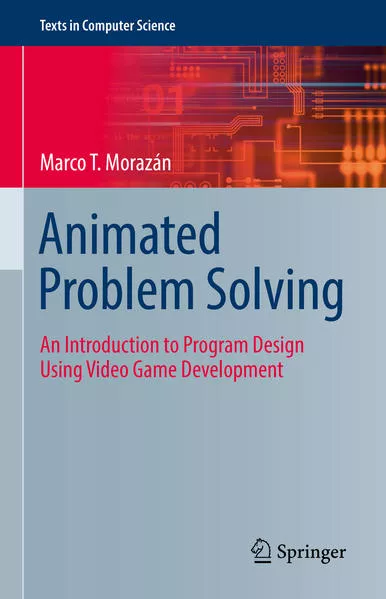Texts in Computer Science
Animated Problem Solving
Chronologie aller Bände (1 - 2)

Die Reihenfolge beginnt mit dem Buch "Animated Problem Solving". Wer alle Bücher der Reihe nach lesen möchte, sollte mit diesem Band von Marco T. Morazán beginnen. Der zweite Teil der Reihe "Animated Problem Solving" ist am 13.01.2022 erschienen. Die Reihe umfasst derzeit 2 Bände. Der neueste Band trägt den Titel "Animated Problem Solving".
- Anzahl der Bewertungen für die gesamte Reihe: 10
- Ø Bewertung der Reihe: 3.75
- Start der Reihe: 13.01.2022
- Neueste Folge: 28.01.2023
- Autor: Morazán, Marco T.
- Anzahl Bewertungen: 3
- Ø Bewertung: 5.0
- Medium: Buch
- Veröffentlicht: 14.01.2022
- Genre: Programmierung
Animated Problem Solving
This textbook is about systematic problem solving and systematic reasoning using type-driven design. There are two problem solving techniques that are emphasized throughout the book: divide and conquer and iterative refinement. Divide and conquer is the process by which a large problem is broken into two or more smaller problems that are easier to solve and then the solutions for the smaller pieces are combined to create an answer to the problem. Iterative refinement is the process by which a solution to a problem is gradually made better–like the drafts of an essay. Mastering these techniques are essential to becoming a good problem solver and programmer.
The book is divided in five parts. Part I focuses on the basics. It starts with how to write expressions and subsequently leads to decision making and functions as the basis for problem solving. Part II then introduces compound data of finite size, while Part III covers compound data of arbitrary size like e.g. lists, intervals, natural numbers, and binary trees. It also introduces structural recursion, a powerful data-processing strategy that uses divide and conquer to process data whose size is not fixed. Next, Part IV delves into abstraction and shows how to eliminate repetitions in solutions to problems. It also introduces generic programming which is abstraction over the type of data processed. This leads to the realization that functions are data and, perhaps more surprising, that data are functions, which in turn naturally leads to object-oriented programming. Part V introduces distributed programming, i.e., using multiple computers to solve a problem.
This book promises that by the end of it readers will have designed and implemented a multiplayer video game that they can play with their friends over the internet. To achieve this, however, there is a lot about problem solving and programming that must be learned first. The game is developed using iterative refinement. The reader learns step-by-step about programming and how to apply new knowledge to develop increasingly better versions of the video game. This way, readers practice modern trends that are likely to be common throughout a professional career and beyond.
- Autor: Morazán, Marco T.
- Anzahl Bewertungen: 1
- Ø Bewertung: 5.0
- Medium: Buch
- Veröffentlicht: 24.09.2022
- Genre: Programmierung
Animated Program Design
This textbook presents a systematic methodology for program development by using design recipes, i.e. a series of steps, each with a specific outcome, that takes a problem solver from a problem statement to a working and tested programmed solution. It introduces the reader to generative recursion, heuristic searching, accumulative recursion, tail recursion, iteration, mutation, loops, program correctness, and vectors. It uses video game development to make the content fun while at the same time teaching problem-solving techniques.
The book is divided into four parts. Part I presents introductory material on basic problem solving and program design. It starts by reviewing the basic steps of a design recipe using structural recursion on a list. It then proceeds to review code refactoring–a common technique used to refine programs when a better or more elegant way is found to solve a problem–and introduces the reader to randomness. Next, Part II explores a new type of recursion called generative recursion. It navigates the reader through examples involving fractal image generation, efficient sorting, and efficient searching techniques such as binary, depth-first, and breadth-first search. Part III then explores a new type of recursion called accumulative (or accumulator) recursion. Examples used include finding a path in a graph, improving insertion sorting, and list-folding operations. Finally, Part IV explores mutation. To aid the reader in properly sequencing mutations it presents Hoare Logic and program correctness. In addition, it introduces vectors, vector processing, in-place operations, and circular data. Throughout the whole book complexity analysis and empirical experimentation is used to evaluate solutions.
This textbook targets undergraduates at all levels as well as graduate students wishing to learn about program design. It details advanced types of recursion, a disciplined approach to the use of mutation, and illustrates the design process by developing a video game exploiting iterative refinement.
